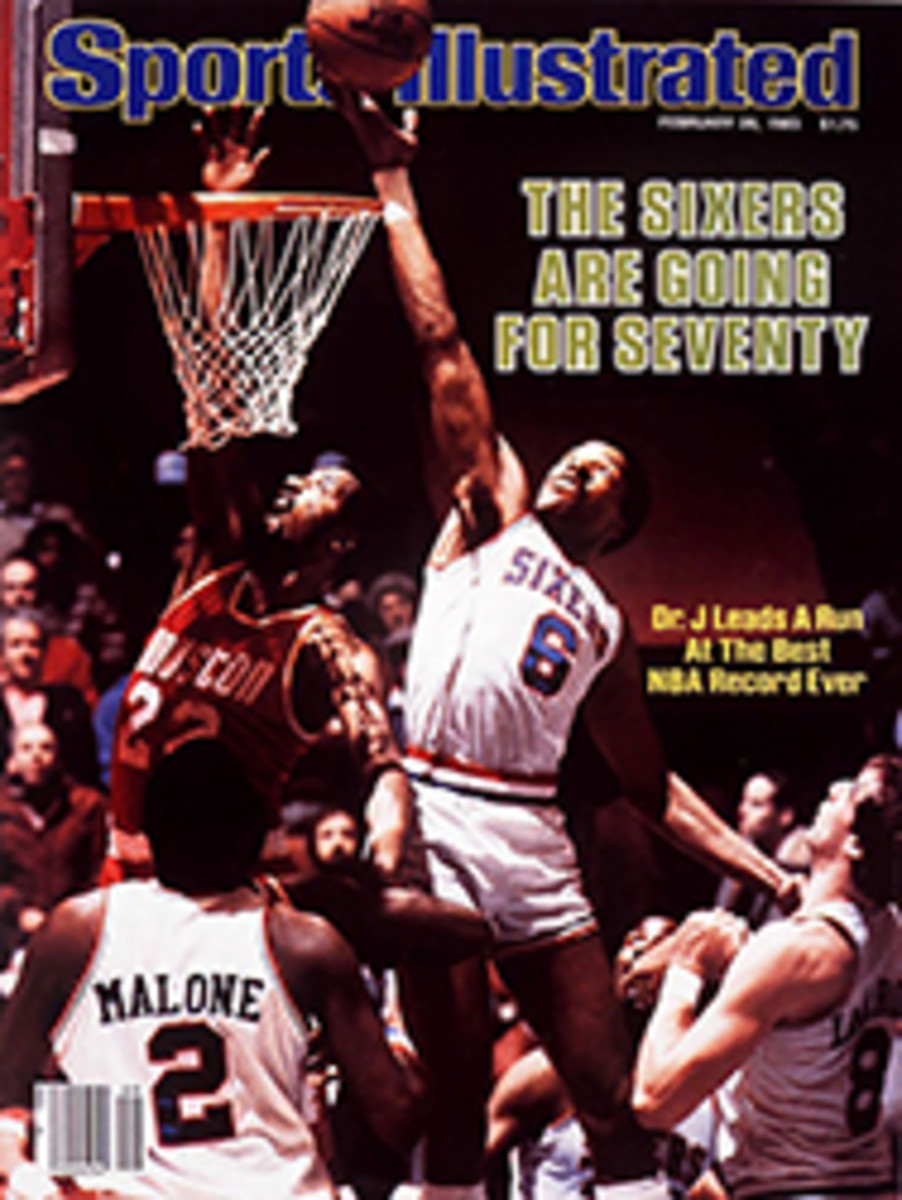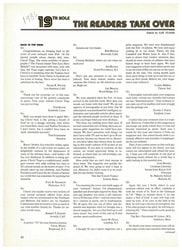
A fleet of flying Dutchmen
The Dutch invaded northern Vermont last week, but some of the citizens of Newport, a faded summer resort on the Canadian border, viewed them more as liberators. "This is the biggest thing that ever happened in Newport," said a dentist as he gazed wonderingly out onto frozen Lake Memphremagog, seeing it with new eyes.
The lake, a 30-mile-long ribbon that links Newport at the south end with Magog, Quebec at the north, is Newport's raison d'être. Its shores are dotted with summer houses, boarded up at this time of year, and in July it's the scene of the town's single civic adventure, the Aquafest. But in winter the lake becomes the property of weekend ice fishermen and snowmobilers. Even the local children, in the main, go elsewhere for fun.
For the Dutch, to whom skating is as natural as walking—but whose canals, probably because of the warming effect of air pollution, no longer can be counted on to freeze every year—Lake Memphremagog with its average ice depth of 16 inches, even in this mild winter, was worth a trip across the Atlantic. Hundreds of them came to Vermont to perpetuate the modern-day version of a two-century-old Dutch tradition, the Elfstedentocht, or Eleven Cities Tour, a 200-kilometer (120-mile) endurance race whose winners are national heroes. "All you get is a medal and a trophy if you win, but your fame is until you die," said Aart Koopmans, a member of the volunteer organization that runs the event.
Nobody invented the Elfstedentocht, it just grew from a regional custom, first noted 220 years ago, to an organized competition on the canals of Friesland, Holland's northernmost province, beginning in 1909. From that year forward, whenever the ice allowed, thousands of Dutch skaters would submit themselves to the worst that nature could provide, while thousands more cheered them from the banks of the canals. Schools and factories were closed, and even the armed forces were given two days off. As Queen Juliana presented the winner his trophy in 1963, the last year the race was held in Holland, the ice on which she stood threatened to give way under the weight of the numbers who wanted to be near the winner. Of the 10,227 who started that year, 577 were serious racers, and of those, only 58 finished. Two skaters died later of exposure, and a third barely survived. In 1929, an especially hard winter, the winner lost his frost-bitten big toe to amputation the day after the race. At his insistence, his descendants kept the toe in a jar for half a century.
The Elfstedentocht is a staggering test of both speed and endurance, but endurance is what wins it, and endurance is the quality the Dutch admire most. The lore of this beloved event is grisly, but the reverence the Dutch feel, not just for the winners but for anyone who has finished, is abiding. Even those who have failed nobly are esteemed—the man with a dislocated shoulder who begged for a string to tie his arm behind his back, the people with frozen corneas who have had to be led out of the dark. "You have to die three times to win," they say.
One of this year's entries, a wiry 47-year-old architect from Havelte in the north of Holland, Jan Roelof Kruithof (pronounced KRAU-toff), had won eight of the last nine Eleven Cities marathons, but all of his victories had been won on foreign ice. After 1963, as the years of waiting for ice in Holland stretched to a decade, an Alternative Eleven Cities Tour Foundation was formed to find ice elsewhere. First Norway was chosen, then Finland and finally, last week. North America. Kruithof won again by skating Jos Niesten, a 29-year-old carpenter from Heemskerk, into mental and physical submission on the rough, fissured ice of Lake Memphremagog, covering the 120 miles in six hours, 58 minutes. As Kruithof's skates clattered and scraped at the crusted, uneven surface of the lake, his face below his goggles turned gray with frost in the 5° air and his dark-blue racing suit turned darker with sweat, but his grim, determined expression never changed. He fell, as everyone does, when the long blades of his skates jammed in almost invisible cracks in the ice, but he scrambled each time to right himself and recover the time lost.
Kruithof started the race slowly. The 700 racers in the Elfstedentocht (540 Dutchmen and 160 "others") crossed the starting line at 7 a.m., just after sunrise. By 9:25 Kruithof was still in 18th place. Niesten, on the other hand, had been at or near the lead from the start, jockeying for position in sprints with the skaters around him, as bicycle racers do. In West Germany two years ago, Niesten set the world record for distance covered in one hour—37 kilometers, 642 meters—breaking Kruithof's record by 671 meters, but that was on a glassy skating oval. By comparison the ice on the course in Vermont looked as though it had been ploughed.
Because of the deteriorating ice, the course on Lake Memphremagog, which originally had been laid out to run more or less directly from Newport to Magog and back, was reset the night before the race. Snowplows and sweepers carved a 100-kilometer serpentine swath through the foot-deep snow at the southern end of the lake, and the skaters were required to complete the course twice. At a halfway checkpoint they were to pause briefly to have their registration cards stamped, a relic of the time when the race was skated on the canals that connected the original 11 towns in Friesland. Customs officials did the stamping in those days. Last Saturday high school girls, fidgety with the weight of their historic responsibility, did the job.
By 9:35 a.m. Niesten had opened up almost half a mile of ice between himself and a pack of nine of Holland's best skaters. With his torso parallel to the ice, his legs pumping rhythmically, his right arm swinging at his side and his bright-red cap leading the way, he looked young, strong and inevitable. "I don't think the old man can do it again," the Dutch driver of a van following alongside the leaders said sadly. He was thinking of Kruithof, too far back and too old at last.
As the exotic procession passed an ice fisherman's weathered hut, a round, florid face appeared at its small window. Black beards and blond beards were white now. Twin icicles two inches long hung from nostrils, and blood from falls mixed with the ice. A stumble in a rough patch at the front of the pack repeated itself through the skaters like a ripple on a pond. Off in the sparkling distance, slower skaters glided across the snowfield in smooth, seemingly effortless silence.
Suddenly out of the pack appeared Kruithof, his thin legs, looking even thinner in their dark-blue tights, set wide apart and moving. In what seemed like no time at all he had fallen in just behind Niesten. Together they reached the halfway checkpoint in three hours, 29 minutes and moved on, stamped but without the cheese sandwiches and hot chocolate that were offered them. At about 120 kilometers Niesten fell and Kruithof barreled ahead. Niesten caught up in short order, but he fell again, at a hairpin turn where uncleared snow required the racers to run like mincing figure skaters for a few yards. Again Niesten caught up. At 11:45 both straightened and, while skating upright, took food from the pouches slung over their shoulders. Then they were back in their crouches. Now Kruithof led, with Niesten so close behind that his nose nearly touched Kruithof's gloved hands, which were clasped at the small of his back. Far behind, the pack had shrunk to invisibility.
At 1:05 p.m., a little over six hours from the start, Kruithof pulled away from his tiring pursuer. He, too, had fallen a couple of times, but the falls seemed to have taken less out of him. Or maybe, as the veterans say, it was a matter of character. At 1:20, by now all alone, Kruithof fell. He was back up quickly, but he slowed his pace to 10 mph. The ice was treacherous at this point, crusted and buckled. He staggered and almost fell again but recovered. From a van, Rein Zwart, a race director and an Elfstedentocht veteran himself, shouted to Kruithof over the roar of the snowmobiles that had joined the leader, "You don't have to look behind you. They are far back. It's better you look at the ice."
By 1:30 the ice had improved some, and Kruithof picked up his speed to 20 mph. His sharp shoulder blades protruded alternately under his blue suit. His face was unchanged, still gray and frosted, his mouth slightly open, but it showed no sign of stress. With five kilometers to go and victory at hand, he tossed his pack and water jug to his friends in a car alongside, a winner sprucing up for the finish. Small family groups that had walked out onto the lake stood beside the track with dogs and cross-country skis. They cheered him on, applauding with mittened hands. He skated lightly over a ridge of broken ice that had risen across the track, forcing the fleet of motorized vehicles to go wide. As he made the last turn for the closing 300 yards to the Newport finish, people ran from a shopping-center parking lot through the snow to the edge of the lake. He crossed the line with his hands over his head and then, as he came to a stop, he was surrounded instantly by a circle, 10 deep, of Dutch reporters and TV cameramen and Vermonters and Quebecois.
At the core of the circle Kruithof was saying, "It was my best marathon ever.... The ice was so bad I was moaning and groaning.... I thought my legs were dropping off.... I will go on skating until I get my pension." Abruptly he bent forward at the waist, disappearing from the view of all but the closest onlookers. His back was shaking. He was crying. He broke from the circle and skated away, and the crowd let him go.
"You see," said a Dutchman, "always, before, there have been doubts. Some people said that the reason he won so often was because all those years not everyone was there, the 'cracks,' the best skaters. But this year everyone was here, and no more doubts are possible."
"Did you know that he cried?" someone asked.
"I am not surprised," said the Dutchman. "So did I."
PHOTO
This Elfstedentocht may have had only one town—but it had plenty of skaters.
PHOTO
Kruithof blossomed in the closing kms.

